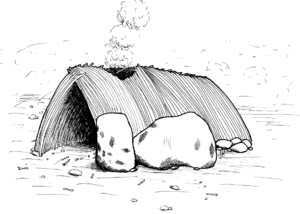Terra Amata (archaeological site) facts for kids
Terra Amata means "Beloved Land" in Italian. It is an important archaeological site located in Nice, France. This open-air site sits on the slopes of Mount Boron, about 26 meters (85 feet) above the Mediterranean Sea.
Archaeologists discovered Terra Amata in 1966. It was excavated by a team led by Henry de Lumley. The site was once a prehistoric beach. It holds amazing clues about people who lived there around 400,000 years ago. These early humans used tools from the Lower Paleolithic period. They also left some of the earliest signs of using and controlling fire in Europe. Today, an apartment building and a museum stand over the site. You can see some of the ancient objects found there in the museum.
Contents
Terra Amata: An Ancient Home
The Terra Amata site was found by accident in 1966. Workers were building a new terrace near the port of Nice when they uncovered ancient remains. Henry de Lumley and his team quickly got permission to dig. They worked very hard, seven days a week, from January to July 1966, to uncover as much as possible.
Discovering a Prehistoric Site
De Lumley's team found several layers of ancient living areas on what was once a sandy beach. These layers showed that people lived there around 380,000 BCE. The most exciting discovery was evidence that these early humans built huts. These huts were likely made from animal skins stretched over poles.
Life in Ancient Huts
Inside each hut, archaeologists found a central fireplace. The ashes in these fireplaces proved that the people of Terra Amata knew how to control fire. This is some of the oldest evidence of fire use in Europe. Similar signs of early fire use have been found at other sites like Menez Dregan in France and Beeches Pit in England.
Mastering Fire
To protect their fires, the ancient inhabitants built low walls of stones and beach pebbles. These walls were placed to block the strong Mistral wind. De Lumley believed the huts had a hole in the roof to let smoke escape. He thought that about 20 to 40 people could live together in one of these shelters. If his ideas are correct, Terra Amata shows some of the first human-made homes ever found in Europe.
Tools from the Beach
The people of Terra Amata were skilled toolmakers. They used stones from the beach to create their tools. Archaeologists found tools with two sharp edges. They also discovered a special type of stone pick, which they named "Pics de Terra Amata." Many other stone tools and scrapers were found in the sand dunes above the ancient beach. These tools helped them with daily tasks like hunting and preparing food.


